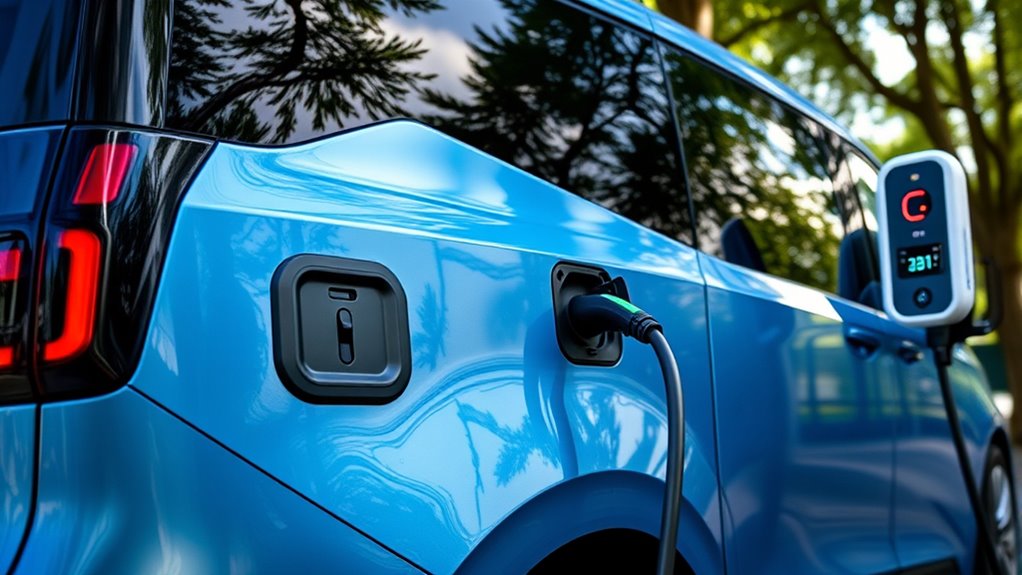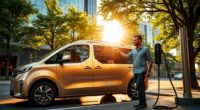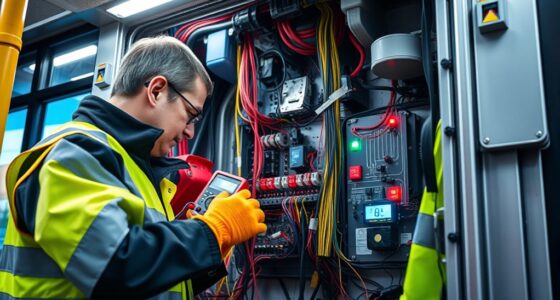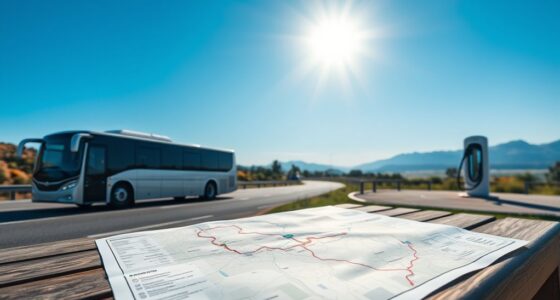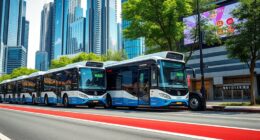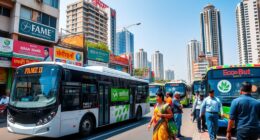To optimize your ID.Buzz’s charging, install a dedicated Level 2 home charger for faster overnight charging, and use smart chargers to schedule when you plug in. Keep battery levels between 20% and 80% to maintain health, avoid keeping it at 100% long-term, and choose the right charging speed for your daily needs. Utilize regenerative braking and plan long trips with fast chargers to save time. For more tips, explore how these practices can extend your battery’s lifespan and save money.
Key Takeaways
- Use a Level 2 home charger for overnight charging, targeting around 80% to preserve battery health.
- Schedule charging during off-peak hours with smart chargers or subscriptions to reduce costs.
- Prioritize fast charging (350kW DC) only for long trips to minimize battery wear.
- Limit charging to 100% unless needed for extended trips, and keep battery levels above 20%.
- Monitor battery temperature and avoid extreme conditions to prevent accelerated degradation.
Optimize Your Home Charging Setup
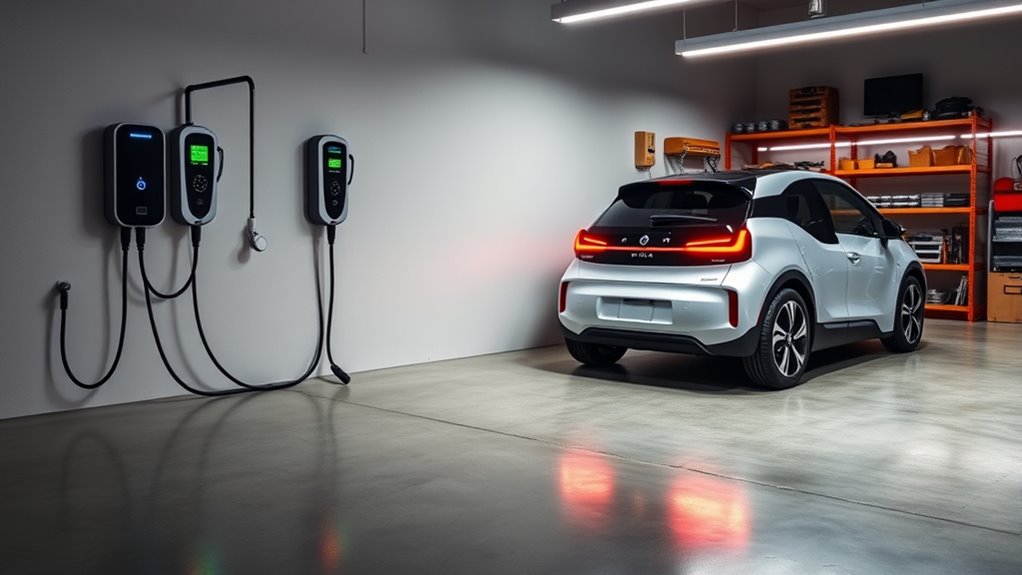
To guarantee your Volkswagen ID. Buzz charges efficiently at home, start by installing a dedicated home charger, preferably Level 2, which uses a 240V circuit. This setup provides faster charging times—about 11 hours for a full charge—compared to standard outlets.
Make sure your home’s electrical system can handle this increased load to prevent overloading. Consider using a smart charger that allows scheduling overnight charges, helping you save energy costs and ensure your vehicle is ready when you need it.
Additionally, verify your electrical system is properly prepared, and inspect your charging equipment regularly for safety and efficiency. Properly optimizing your home charging setup minimizes inconvenience and maximizes your vehicle’s range and performance. For optimal results, ensure your home electrical system is compatible with high-capacity charging stations to avoid potential issues. Regularly monitor your electrical capacity to maintain safety and efficiency during charging.
Understanding the power requirements of your charger can also help prevent overloads and improve overall charging reliability.
Choose the Right Charging Speed for Your Needs
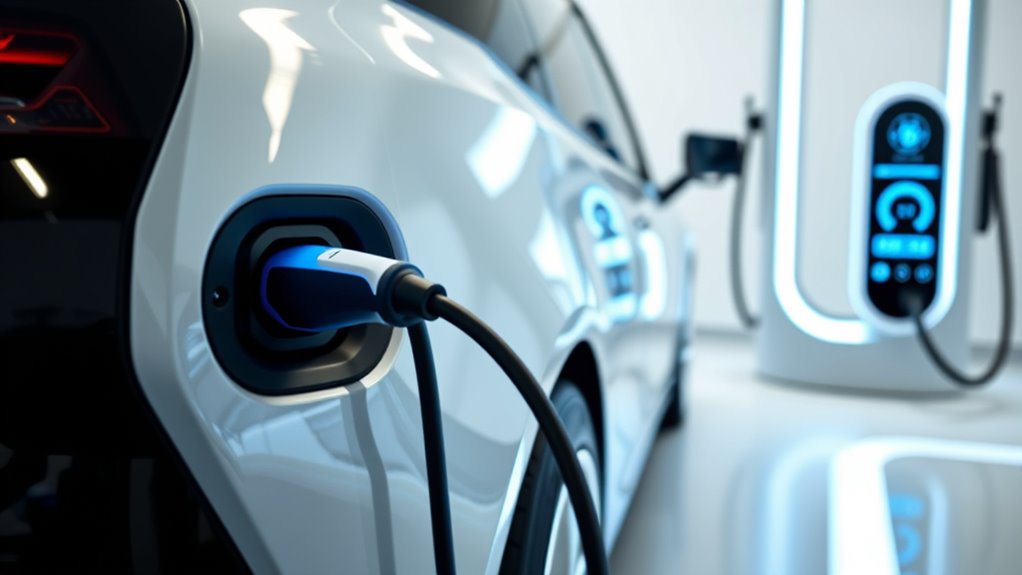
Selecting the appropriate charging speed for your ID.Buzz depends on your driving habits and schedule. Using the right charger guarantees you’re balancing convenience, cost, and battery health. Proper battery management is essential to prolonging your vehicle’s lifespan and maintaining optimal performance. For daily commuting, slower AC charging works well, while fast charging is best for longer trips to minimize downtime. Additionally, understanding different home charging options can help you choose the most suitable setup for your needs. Adjust your charging speed based on your routine to optimize efficiency and battery longevity.
Set Appropriate Charging Targets for Battery Longevity
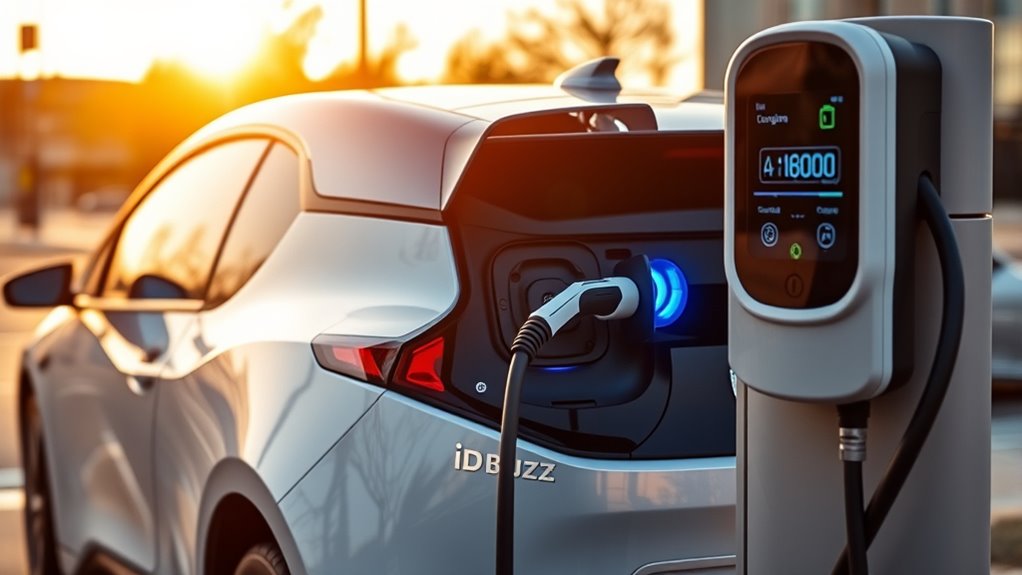
Charging habits directly impact your ID.Buzz’s battery health over time. To improve longevity, avoid frequently charging to 100%, as this stresses the battery. Instead, set your daily charging target to around 80%, which helps conserve battery capacity.
For long trips, charging to 100% is recommended, but don’t keep the battery at full charge for extended periods. Keep the battery level above 20% to prevent deep discharges that can damage it. Using proper charging practices can significantly extend your battery’s lifespan. Additionally, maintaining optimal temperature conditions is essential, as extreme temperatures accelerate battery degradation. Regularly checking your vehicle’s battery management system can provide insights into its health and help prevent potential issues. Incorporating user-centered design principles can help tailor charging routines to your specific driving habits for better battery care.
When storing your vehicle long-term, maintain a charge between 30% and 80%. Use your car’s pre-set charging limits and automatic cutoffs to prevent overcharging.
Monitoring your charge levels and avoiding extreme temperatures also help maintain ideal battery health. Balancing these practices ensures your ID.Buzz’s battery remains healthy and efficient over time.
Plan Charging Around Your Daily Routine
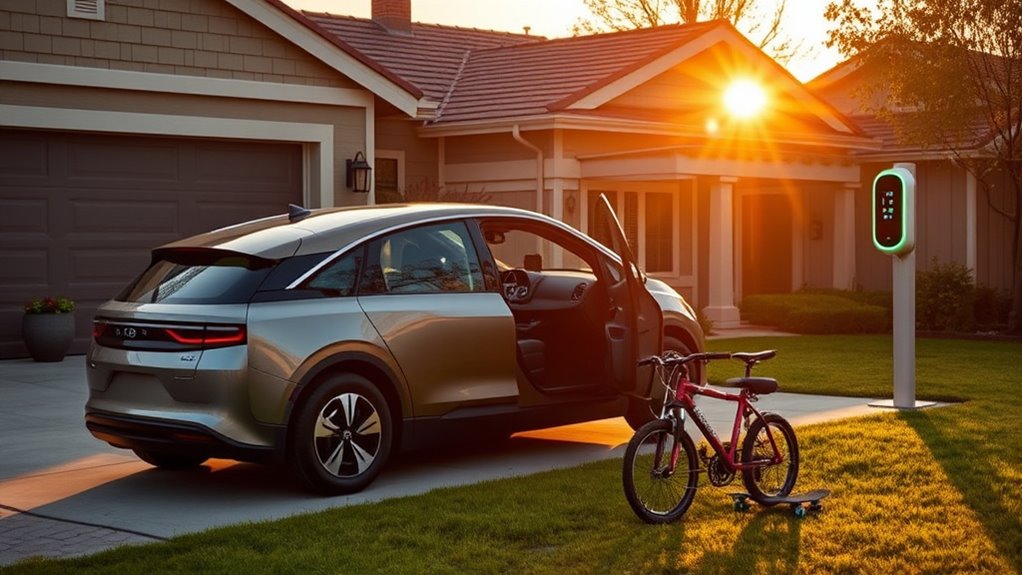
Aligning your ID.Buzz’s charging schedule with your daily routine maximizes convenience and efficiency. You can set scheduled charging times to match when you’re home or at work, ensuring your vehicle is ready when needed. Utilize location-based charging preferences to automatically activate charging at specific spots, like your driveway or office parking lot. Take advantage of off-peak hours by scheduling overnight charging, which reduces energy costs and minimizes strain on the grid. If your daily trips require a full battery, plan to top up during low-demand periods. With features like percentage control, you can specify charging limits to preserve battery health. Additionally, understanding the cost and budgeting involved in various charging options can help optimize your expenses over time. Sound vibrations are believed to enhance cellular regeneration and overall health, so automating these routines can support your vehicle’s battery longevity while keeping it charged and ready, all while optimizing costs and integrating seamlessly into your daily life.
Use Regenerative Braking to Maximize Range
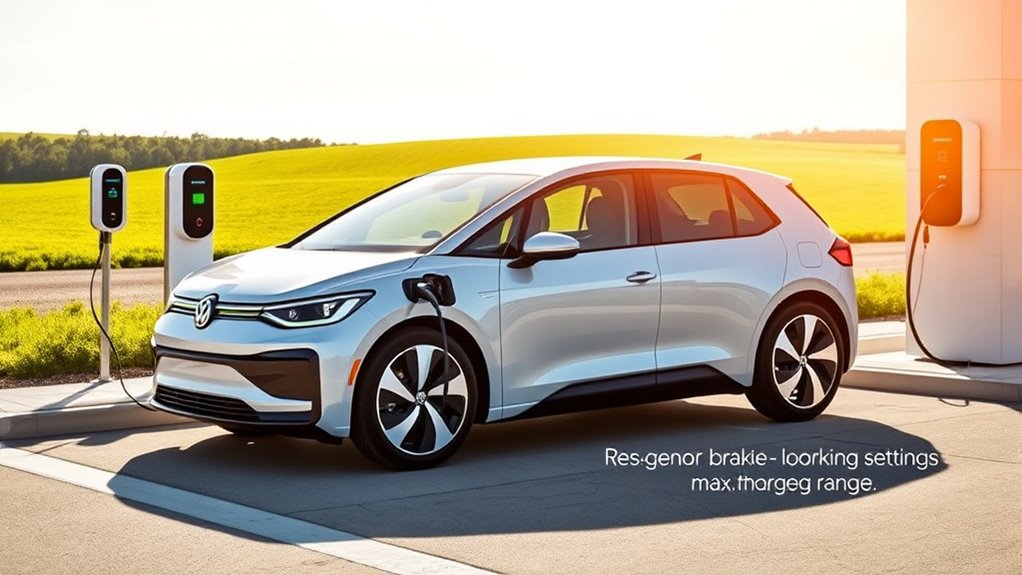
Regenerative braking is a powerful feature that can help you extend your ID.Buzz’s range by recapturing energy during deceleration. When you lift off the accelerator, the system converts kinetic energy into electrical energy, recharging the battery. Using organic and natural juices as a metaphor, think of regenerative braking as ‘natural’ energy recycling—maximizing efficiency and sustainability. The ID.Buzz offers two modes: ‘D’ for minimal regeneration and ‘B’ for stronger recovery. Switching to ‘B’ mode via the steering-wheel stalk maximizes energy recovery, especially in city driving with frequent stops. To get the most benefit, drive smoothly—accelerate gently and brake gradually. Consistently using regenerative braking, particularly in urban environments, helps maintain and extend your vehicle’s range. Additionally, understanding optimal driving techniques can further enhance regenerative efficiency. Practicing smooth acceleration and deceleration not only conserves energy but also reduces wear on your vehicle’s components, promoting longevity. Keep in mind that aggressive driving reduces regenerative efficiency, while a calm driving style optimizes energy recapture and overall battery life.
Manage Battery Storage When Not in Use
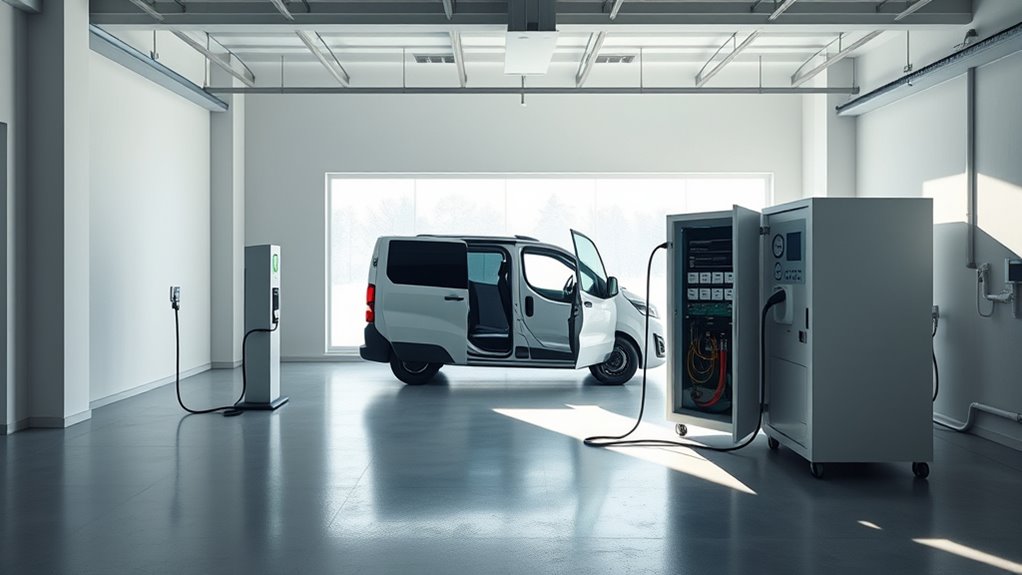
To guarantee your ID.Buzz’s battery remains in good condition when not in use, it’s important to follow proper storage practices. Keep the vehicle in a moderate temperature environment, avoiding extreme heat or cold that can harm the battery. Store the battery at around 50% charge to prevent deep discharge, which can damage lithium-ion cells. Regularly check for signs of damage or wear, and ensure the high-voltage system is de-energized before handling. Be aware of family influences that can shape vehicle maintenance habits and decision-making. Avoid tampering with high-voltage components, as they can pose safety risks. Be cautious of coolant leaks from the cooling system, monitoring temperature to prevent thermal reactions. Additionally, understanding security considerations is essential when handling electrical components to prevent accidental harm. Maintaining proper emotional well-being during storage routines can help promote a mindful approach to vehicle care and safety. Proper battery management can extend the lifespan of your vehicle’s battery and optimize performance over time.
Leverage Public Charging Networks Effectively

Leveraging public charging networks efficiently is key to maximizing your ID.Buzz’s electric range and minimizing downtime. With Electrify America’s Pass+ membership, you get three years of 25% savings and access to over 4,250 chargers nationwide, including 970+ Hyper-Fast DC stations.
Maximize your ID.Buzz’s range with Electrify America’s Pass+ and strategic charging.
Use the Plug&Charge feature for seamless authentication at Electrify America locations, and prioritize 350kW DC stations for faster charging—around 30 minutes to reach 80%. Selecting a high-efficiency charging station can significantly reduce your total charging time during long trips.
Plan routes with the Electrify America app to check station availability and avoid delays. Target charging stops when your battery’s between 20-80%, and cluster stops near amenities during long trips.
Cross-reference station info with third-party tools, identify backup stations nearby, and report issues promptly to keep your charging experience smooth and efficient. Being aware of potential regulatory compliance challenges can help you stay prepared for any changes that might impact your charging plans.
Understand Costs and Find Affordable Charging Options
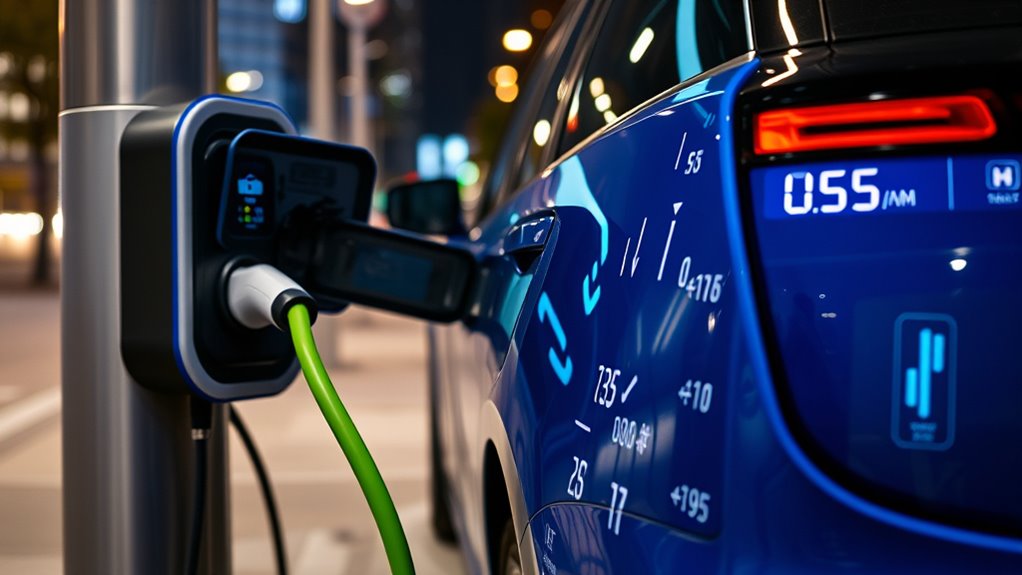
Understanding the costs associated with charging your ID.Buzz is essential for managing your overall expenses and finding affordable options.
Home charging with an Economy 7 tariff can cost around £5.93 for an 80% charge overnight, especially if you use an efficient 11 kW wallbox.
Using programmable chargers like Ohme helps you align charging with off-peak rates.
Subscribing to providers such as BP Pulse can lower costs compared to guest plans, and app discounts further reduce expenses.
Public chargers vary in price, with contactless payments often more costly than subscription-based access.
To save, focus on charging during off-peak hours from midnight to early morning and avoid high-cost fast chargers unless necessary.
Smart planning helps balance convenience and affordability, keeping your long-term costs manageable.
Incorporate Fast Charging for Long Trips

Incorporating fast charging into your long trips with the ID.Buzz guarantees you spend less time waiting and more time enjoying the journey. The vehicle supports DC fast charging, allowing you to go from 10% to 80% in about 30 minutes, which is ideal for quick top-ups on the road.
With a strong 111kWh battery, you’ll get approximately 300 miles of range, making long-distance travel feasible.
The ID.Buzz is compatible with advanced charging networks, including Plug&Charge technology for seamless, hassle-free charging.
Strategically located fast charging stations help you minimize downtime, keeping your trip efficient. Planning your route to include these stations ensures you stay on schedule and make the most of your scenic or multi-day adventures.
Practice Efficient Driving Habits to Extend Range
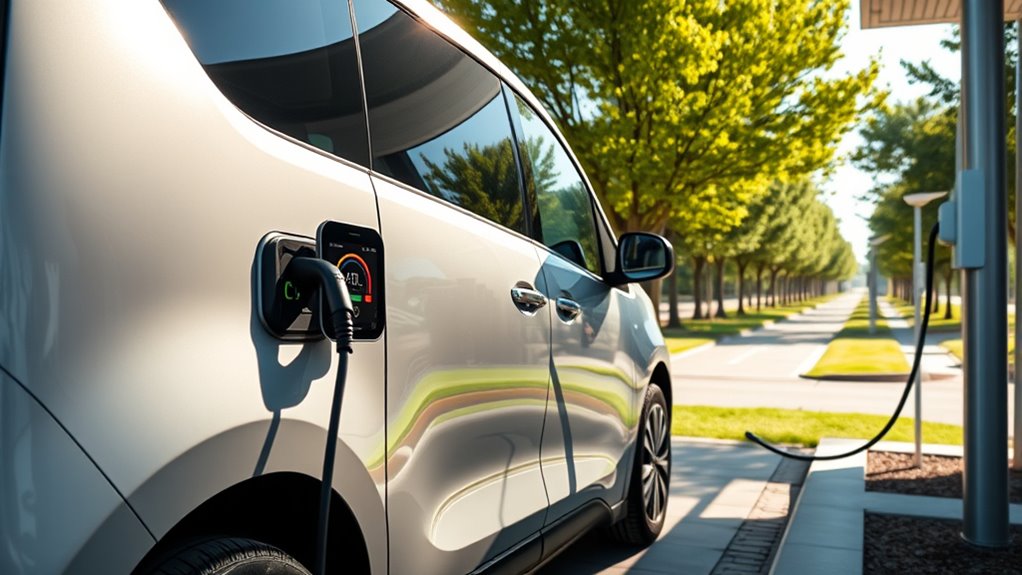
Practicing efficient driving habits can considerably extend the range of your ID.Buzz. Keep your speed steady between 65–70 mph on highways, as higher speeds increase air resistance and reduce efficiency. Avoid exceeding 75 mph, especially in cold weather, since it cuts range markedly.
Use cruise control to maintain a consistent speed and optimize your route with EV navigation systems to avoid steep inclines and optimize terrain. Accelerate smoothly, anticipate stops, and use regenerative braking to recover energy.
Activate Eco mode to limit power output and maximize efficiency. Pre-condition the cabin while plugged in to conserve battery during trips. Limit unnecessary cargo, avoid external accessories, and keep windows closed at high speeds.
These habits help stretch your battery life and increase your ID.Buzz’s driving range.
Frequently Asked Questions
How Do I Safely Upgrade My Home Charging Station?
To safely upgrade your home charging station, start by having a licensed electrician assess your electrical system’s capacity. They’ll help you install a dedicated 240V circuit compatible with your vehicle’s charger.
Make sure to choose UL-listed equipment and follow local codes.
Regularly inspect your charging setup for wear or damage, keep the area clear of hazards, and avoid using extension cords.
Proper installation and maintenance guarantee safe, efficient charging.
Can I Use a Standard Household Outlet for Charging My ID.Buzz?
You might think a standard household outlet isn’t enough for your ID.Buzz, but it can work.
While charging is slow—about 2-5 miles per hour—you can still top up overnight or during long stops.
Just make certain you’re using a proper NEMA 5-15 outlet, and consider an adapter if needed.
Keep safety in mind with modern chargers that include protection features, but for faster charging, a Level 2 setup is recommended.
What Are the Signs of Battery Degradation From Frequent Fast Charging?
You notice signs of battery degradation from frequent fast charging when your ID.Buzz’s range decreases, and it takes longer to fully charge.
You might also feel reduced power or experience slower acceleration. Watch for alerts on your vehicle’s display indicating battery issues.
In cold weather, degradation effects can worsen. To prevent this, try to limit rapid charging and follow manufacturer guidelines for best battery health.
How Does Temperature Affect Charging Speed and Battery Health?
Imagine your battery’s performance as a delicate dance affected by the weather. Cold temperatures slow down chemical reactions, making charging take longer and stressing the battery’s health.
You might notice longer waits and reduced efficiency. To keep things smooth, precondition your battery, park in warm spots, or use heating systems.
Staying mindful of temperature helps preserve your battery’s longevity and keeps your charging experience swift and reliable.
Is It Better to Charge to 80% or 100% Before Long Trips?
When preparing for long trips, you should charge your vehicle to 100% to maximize range. Charging only to 80% for daily use helps preserve battery health, but for long journeys, reaching full capacity guarantees you get the most out of your battery.
Just remember to start your trip with a full charge, and avoid unnecessary deep discharges to keep your battery in good condition over time.
Conclusion
Think of charging your ID.buzz like tending a garden—consistent care guarantees it thrives. By following these best practices, you’ll keep your battery healthy, extend your range, and enjoy smooth rides. Just like watering plants regularly, sticking to a routine prevents surprises and keeps your electric journey running effortlessly. With a little planning and mindful habits, you’ll be driving confidently, knowing your vehicle is always ready to go—turning everyday trips into a breeze.
